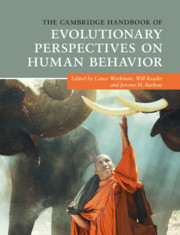Book contents
- The Cambridge Handbook of Evolutionary Perspectives on Human Behavior
- The Cambridge Handbook of Evolutionary Perspectives on Human Behavior
- Copyright page
- Dedication
- Contents
- Figures
- Tables
- Contributors
- Preface
- Acknowledgments
- Part I The Comparative Approach
- Part II Sociocultural Anthropology and Evolution
- Part III Evolution and Neuroscience
- Part IV Group Living
- Part V Evolution and Cognition
- Part VI Evolution and Development
- Part VII Sexual Selection and Human Sex Differences
- Part VIII Abnormal Behavior and Evolutionary Psychopathology
- Part IX Applying Evolutionary Principles
- Part X Evolution and the Media
- 42 Daily Talk Shows as Virtual Gossip Communities
- 43 Supernormal Stimuli in the Media
- 44 An Evolutionary Approach to Horror Media
- 45 The Internet Is for Porn
- Index
- References
42 - Daily Talk Shows as Virtual Gossip Communities
from Part X - Evolution and the Media
Published online by Cambridge University Press: 02 March 2020
- The Cambridge Handbook of Evolutionary Perspectives on Human Behavior
- The Cambridge Handbook of Evolutionary Perspectives on Human Behavior
- Copyright page
- Dedication
- Contents
- Figures
- Tables
- Contributors
- Preface
- Acknowledgments
- Part I The Comparative Approach
- Part II Sociocultural Anthropology and Evolution
- Part III Evolution and Neuroscience
- Part IV Group Living
- Part V Evolution and Cognition
- Part VI Evolution and Development
- Part VII Sexual Selection and Human Sex Differences
- Part VIII Abnormal Behavior and Evolutionary Psychopathology
- Part IX Applying Evolutionary Principles
- Part X Evolution and the Media
- 42 Daily Talk Shows as Virtual Gossip Communities
- 43 Supernormal Stimuli in the Media
- 44 An Evolutionary Approach to Horror Media
- 45 The Internet Is for Porn
- Index
- References
Summary
During the 1990s, the daily talk show became a popular television format in Germany as well as in other countries; stations worldwide began to fill many hours of afternoon viewing with such programming, which typically involves the participation of one or more hosts and a number of invited guests, often ordinary people, who provide expertise, recount an event, or simply share their point of view on a given topic.
In addressing the evolutionary significance of gossip, Barkow (1992 , p. 628) hypothesized a classification of relevant topics (“relative standing and anything likely to affect it, control over resources, sexual activities, births and deaths, current alliances/friendships and political involvements, health, and reputation about reliability as a partner in social exchange”), as well as the categories of people who are the subjects of gossip (“relatives, rivals, mates, offspring, partners in social exchange, and the very high ranking”). In this study, these two classifications were tested against and compared with a quantitative content analysis of the talk show topics for 1996 derived from the main daily talk shows on four of the five major German television networks.
All of the hypothesized categorical topics and persons were present, but it was necessary to add three additional topics (“family business,” “aesthetics,” and “dangers”) and two categories of people (“me” and “animals”; pets were usually classified as people rather than topics as they frequently tend to be considered as family members).
Since the number of viewers for each episode was also coded, the effect or success of the various topics and hosts could be numerically calculated. The host is the single most important factor affecting number of viewers. If we assume that this stability reflects a strong core of regular viewers, it would appear that we are looking at the formation of relatively stable virtual gossip groups attendant to a central figure, the talk show host.
This chapter also characterizes the differences between everyday conversation and gossip and, in an effort to further understand the function of mass media, it addresses the highly ritualized nature of the television talk show.
- Type
- Chapter
- Information
- Publisher: Cambridge University PressPrint publication year: 2020



